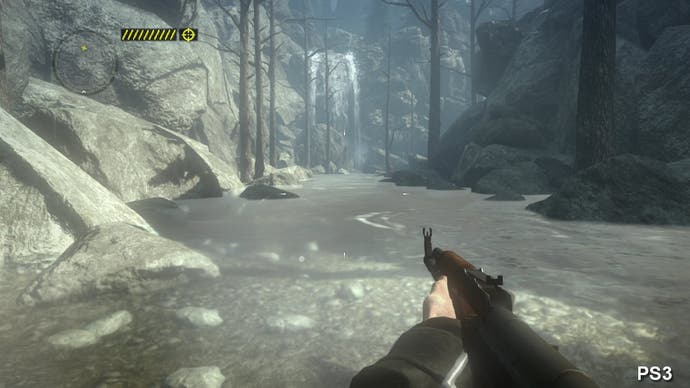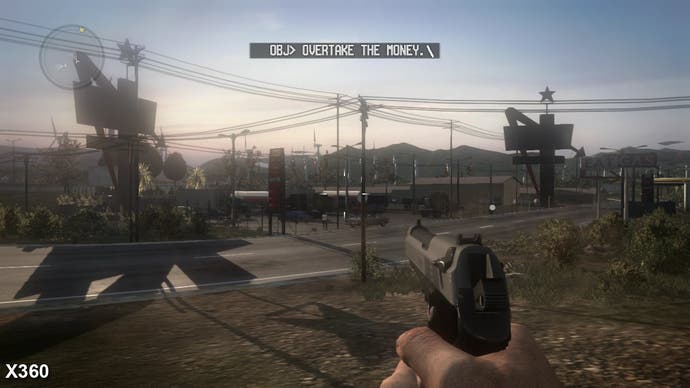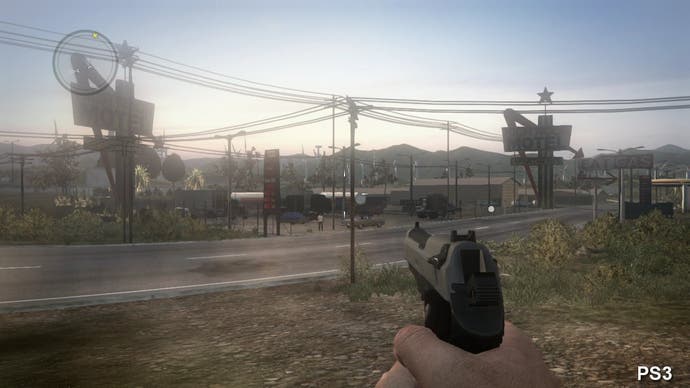Face-Off: Call of Juarez: The Cartel
Mexcian stand-off.
As with many new releases, screen space ambient occlusion (SSAO) is present in both versions of Call of Juarez: The Cartel, subtly adding extra depth to the scene. While not being artifact-free, the implementation here is a touch more refined than what we've seen in recent titles such as F.E.A.R. 3, L.A. Noire on PS3 and Homefront. Another impressive effect is the implementation of lightshafts in many areas of the game, central to the lighting scheme in the outdoor environments and an element that features a visibly stronger implementation on the PlayStation 3.
Alpha buffers (used for displaying smoke, fire and particles amongst other things) are handled in much the same way on both platforms, but there are some curious differences: in some cases we see that certain smoke effects are absent on the Sony platform, while the main explosions are left completely intact. On the other hand, environmental reflections found on water surfaces throughout the game are missing on PS3, perhaps suggesting that bandwidth constraints are an issue - something that correlates with the drops in performance when transparent alpha-based effects are being thrown about.




Some of the oddities present in our comparison gallery and head-to-head video appear to be more down to rendering bugs and a distinct lack of polish as opposed to raw technological limitations in either console. In a few areas the lighting model doesn't match up between both versions, with some light sources being notably absent on the PS3 leading to a flatter looking image. Water surface lighting also appears rather overblown and there's a significant amount of missing shadows, robbing the scene of some much needed depth.
Moving onto performance, it's clear that Techland has completely changed its approach to frame-rate in its console titles with this new game. Both of its previous releases (Call of Juarez: Bound in Blood and insane off-roader Nail'd) run without v-sync on both formats alongside an uncapped frame-rate. This leads to a theoretical increase in controller response, the downside being some extremely unattractive screen-tear. Performance analysis of the new game reveals that the frame-rate has now been capped at 30FPS on both platforms, dramatically reducing screen-tear - on 360, at least, and greatly aiding visual consistency.
In addition to capping frame-rate, Techland has followed the general consensus amongst first person shooter developers in disengaging v-sync when performance drops below the target 30FPS. As you can tell from the video, tearing in general is far more pronounced on the PS3, with the engine struggling to render out finished frames in time for the next screen refresh, while larger drops in performance are also far more commonplace in scenes that really tax the engine. Both controller response and image consistency are both compromised when this happens, impacting on the overall experience.
In comparison, things are generally smoother on the 360, with dips in frame-rate being both less severe and less frequent across the board, and tearing in particular is much less of an issue. Of course, there is some commonality between the two: large gunfights and screen-filling explosions cause issues for both versions, but it's clear that performance definitely favours the 360 release: across the basic run of play the action feels smoother and image consistency is higher.
All things considered, both versions are perhaps worth picking up if you want something to tide you over through the current drought of top-tier releases, but given the choice between the two, our final recommendation rests with the 360: the graphical make-up of the game is tighter, with higher resolution effects and less buggy lighting delivering greater visual consistency. Much more importantly, performance is tangibly better, translating into a smoother, more responsive gameplay experience.
That said, there are some benefits for the PS3 version: the higher resolution framebuffer yields a slightly clearer image, and a stronger (perhaps more overpowering) ambient lighting effect in some areas beefs up the look of effects such as the light shafts. Streaming might not be the game's strongest point, but it's still tangibly better than it is on the Xbox 360. Overall, it's just a shame that image consistency is compromised so much by the dips in performance and the resultant screen-tear.
Techland took a risk in uprooting the Call of Juarez series and relocating it to modern day Los Angeles and it's a gamble that hasn't completely paid off: a key component of what made the series separate and distinct from its competitors has now been lost and the new setting doesn't seem to represent that much of an upgrade. Technologically, there have been some obvious improvements with the engine but this doesn't necessarily translate into a better looking game. It appears that the art design, more than anything else is the issue here.
On the other hand, Call of Juarez: The Cartel is still quite a lot of fun to play if you can lower your expectation levels. The shooting perhaps gravitates more towards the whack-a-mole style of an arcade light gun game - with enemies literally jumping out from behind creates and doorways - but the mechanics are reasonably solid and the multi-character, three-player campaign mode provides a good enough reason to return. Bound in Blood and the original Call of Juarez may well be better games, but The Cartel certainly isn't a bad effort - just a little uninspired and lacking polish.
Article by David Bierton.






